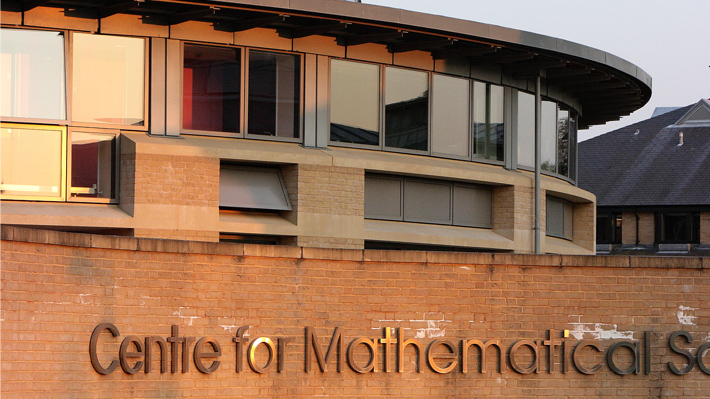A History
For over three centuries the Faculty of Mathematics in the University of Cambridge has been famous for its work in fundamental science. Cambridge Mathematics currently boats over 23 Fellows of the Royal Society and six Nobel Prize winners were members of the Faculty at some stage in their careers.
The Faculty relocated to the purpose-built Centre for Mathematical Sciences in 2002 - a move made possible by generous donations from private sources. The new site includes the Betty & Gordon Moore Library, housing the University's research collections in mathematics, the physical sciences and technology.
The Department of Applied Mathematics and Theoretical Physics (DAMTP) is one of two Mathematics Departments at the University of Cambridge, the other being the Department of Pure Mathematics and Mathematical Statistics (DPMMS). The two Departments together constitute the Faculty of Mathematics, and are responsible for the teaching of Mathematics and its applications within the Mathematical Tripos.
DAMTP was first established as a Department of the University of Cambridge in 1959, by George Batchelor. Although on the timescales of the University of Cambridge DAMTP was founded relatively recently, research in applied mathematics and theoretical physics has developed in Cambridge over more than 300 years through the great traditions established by the giants of the past, including Newton, Clerk Maxwell, Babbage, Eddington and Dirac. The oldest Professorship in Mathematics is the Lucasian Professorship, established in 1663, held by Sir Isaac Newton, Paul Dirac, Sir James Lighthill and, between 1979 and 2009, Professor Stephen Hawking. In 2009 Michael Green, one of the pioneers of String Theory, was elected the 18th holder of the Lucasian Professorship. In 2015 he was succeeded by Michael Cates.
DAMTP has a 50-year tradition of carrying out research of world-class excellence in a broad range of subjects across applied mathematics and theoretical physics. Members of DAMTP have made seminal theoretical advances in the development of mathematical techniques and in the application of mathematics, combined with physical reasoning, to many different areas of science. Research students have always played a crucial role in DAMTP research, working on demanding research problems under the supervision of leading mathematical scientists and, in many cases, moving on to become research leaders themselves. The current aims of DAMTP are to continue this tradition, in doing so broadening the range of subject areas studied and using new mathematical and computational techniques.

The Centre for Mathematical Sciences has been the home of mathematics in Cambridge since 2002
Relativity and Gravitation and the Centre for Theoretical Cosmology
The Relativity and Gravitation Group within DAMTP was started by Dennis Sciama in 1961 and is currently headed by Professor Stephen Hawking. It is internationally renowned for a number of important developments in Einstein's classical theory of gravitation, including the no hair and area theorems for black holes and the theorems indicating that singularities would occur both in gravitational collapse and at the beginning of the expansion of the Universe. In recent years the group's main effort has been towards the inclusion of quantum effects and the development of a theory of quantum gravity. Furthermore, the group has expertise in the areas of supergravity, string and membrane theories of gravity, cosmology, cosmic strings, the cosmic microwave sky, numerical and discrete relativity. In addition, the group houses and operates the COSMOS supercomputer, the UK national cosmology supercomputer.
The idea for the Centre for Theoretical Cosmology grew out of discussions between Dennis S. Avery and Stephen Hawking at Stephen’s 60th Birthday conference in 2002. Stephen wanted to establish an endowment to provide permanent support for research in theoretical cosmology in Cambridge. Denis conceived of this as a “Newton’s Nest”, a place where the next Isaac Newton or Albert Einstein could emerge to revolutionise our understanding of the Universe. With the generous support of Dennis and his wife Sally Tsui Wong-Avery, the Stephen Hawking Trust Fund, which now supports the CTC, was established within the University.
DAMTP also includes a renowned High Energy Physics group including pioneers in string theory and particle physics, many with an interesting cosmology. The Centre for Theoretical Cosmology draws all of these groups together and also strengthens links with researchers in the nearby Cavendish Laboratory and the Institute of Astronomy. Cosmologists from all three Departments meet weekly for a seminar in DAMTP.
